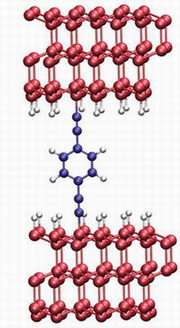Building a Molecular Computer Chip
For Dr. Jerry Bernholc, a trip to Oak Ridge National Laboratory (ORNL) is like a suburbanite’s trek to Costco. Bulk consumption is the name of the game.
Bernholc, the Drexel Professor of �鶹��Ժics at North Carolina State University, spends more hours conducting research on supercomputers each year than all but a handful of U.S. scientists. Using the powerful computers – like ORNL’s -- to crunch numbers is the only way to get results for the complex calculations he uses to study molecules.

Bernholc is trying to keep intact one of technology’s great streaks—Moore’s Law. Gordon Moore, the co-founder of semiconductor giant Intel, predicted in 1965 that the number of transistors the industry would be able to fit onto a computer chip would double every 18 months. The prediction has become a guiding principle for the semiconductor industry, which continually delivers more powerful chips. But upholding Moore’s Law for 40 years has pushed the industry to the brink of running out of space on computer chips.
“The limits of standard silicon technology are coming into play,” Bernholc says. “Beyond 2011 or 2012, the industry has some ideas for future growth, but it has no roadmap to get there.”
So Bernholc is pointing the industry in the direction of molecular technology. His computer simulations have demonstrated that many small molecules exhibit a property known as negative differential resistance. As voltage is increased, the current flowing through molecules drops, Bernholc says, meaning they can be used as switches. Previously, scientists thought negative differential resistance was limited to just a few molecules.
“Designers can focus on processing semiconductors instead of trying to arrange specific molecules, which is difficult at the nanoscale level,” he says. Bernholc also is working with a scientist from his native Poland on “spin electronics”—understanding and devising materials where the spin of electrons is used to control the flow of electricity.
ORNL, where Bernholc holds the title of Visiting Distinguished Scientist, already has one of the fastest supercomputers in the world, but is looking for a system a hundred times more powerful. Bernholc’s research might play a role in developing such a system.
“I’m looking at faster transistors, which could produce faster computers, which would then allow me to do simulations on even faster transistors,” he says with a laugh. “It could be an endless loop, but much more study is needed to understand molecular electronics before we can actually produce these transistors.”
For more information, please visit
Source: NC State University




















